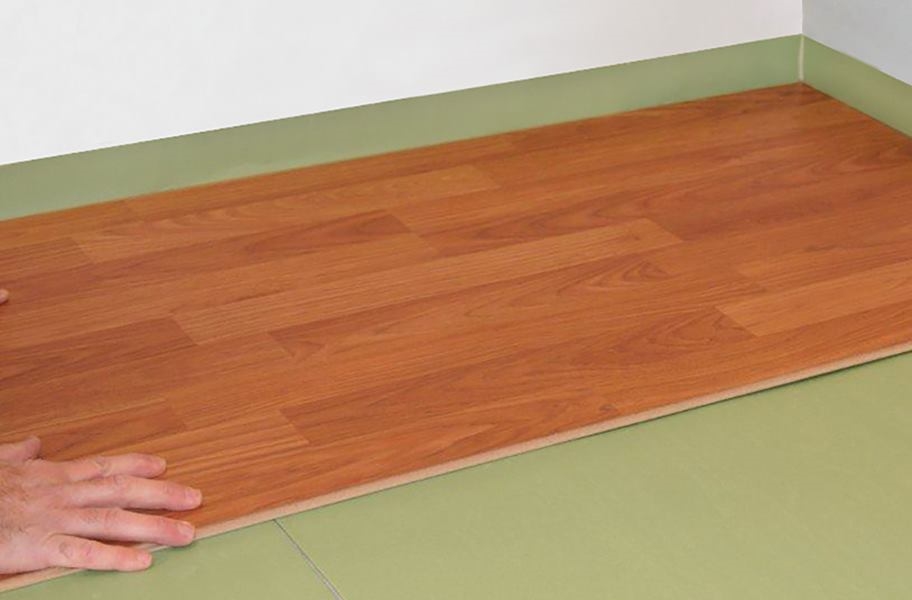My neighbor, a seasoned DIYer, was recently renovating his basement. He chose laminate flooring for its affordability and stylish look. But when it came to installing it over the concrete slab, he was stumped. A friend suggested he install a moisture barrier, but he wasn’t sure if it was truly necessary. This got me thinking – how important is a moisture barrier when placing laminate flooring on a concrete floor? It’s more crucial than you might think.

Image: sayenscrochet.com
After doing some research, I learned that while laminate flooring is known for its durability and water resistance, it’s not entirely impervious to moisture. Concrete floors often contain moisture, especially in basements or areas with high humidity. This moisture can seep through the gaps in the laminate flooring, causing it to warp, swell, and even rot. A moisture barrier can significantly reduce the risk of these issues, ensuring your new flooring lasts for years to come.
Understanding Moisture Barriers
What is a Moisture Barrier?
A moisture barrier is a protective layer placed between the concrete floor and your laminate flooring. It acts as a shield, preventing moisture from the concrete from reaching the flooring. These barriers come in various materials, including:
- Polyethylene sheeting: This is a common, cost-effective option, readily available in various thicknesses.
- Moisture-resistant underlayment: This thicker material provides insulation and moisture protection.
Why are Moisture Barriers Important?
Concrete floors are porous and can hold moisture, especially in humid climates or areas with high groundwater levels. Even if you believe your basement floor is dry, it’s essential to address the potential for moisture penetration. Moisture can seep through the gaps between flooring planks, causing the core to swell and warp.
Moisture barrier installation not only extends the lifespan of your laminate flooring but also prevents other problems. The wood in the core of laminate flooring is susceptible to decay due to moisture. This can lead to mold and mildew growth, impacting your indoor air quality and potentially causing allergy problems.

Image: www.flooringinc.com
Deciding Whether You Need a Moisture Barrier
Determining whether your concrete floor requires a moisture barrier is crucial. You can assess your situation by considering the following factors:
1. Concrete Slab Moisture Levels
Measure the concrete slab ‘s moisture content using a moisture meter. If the reading is above the manufacturer’s recommendations for the chosen laminate flooring, a moisture barrier is a must. Even if the measurement falls within acceptable ranges, consider using a moisture barrier as an extra safety measure.
2. Climate and Location
If you live in a humid climate, your basement is more likely to be affected by moisture. Basement floors in these areas often require a moisture barrier to prevent problems.
3. Previous Flooring
If the current flooring is carpet, you need to identify whether it has been affected by moisture. If it has, a moisture barrier is vital for the new flooring.
4. Manufacturer Recommendations
Always consult the manufacturer’s recommendations for your chosen laminate flooring. Some manufacturers might advise against using a moisture barrier. However, It’s generally a good idea to use one as it safeguards against unexpected moisture issues.
Expert Advice for Moisture Barrier Installation
Here are some expert tips for installing a moisture barrier:
- Prepare the concrete floor by cleaning it thoroughly to ensure it’s free of debris.
- Overlap the sheets of polyethylene or underlayment by at least six inches to prevent moisture from seeping through.
- Use a moisture-resistant adhesive tape to securely seal the seams of the moisture barrier. The tape should be compatible with the chosen material, sealing any gaps.
- Ensure that the moisture barrier is properly installed throughout the entire floor area.
Following these steps ensures the effectiveness of your moisture barrier, offering optimal protection for your laminate floor.
FAQ
Q: Can I use a moisture barrier with any type of laminate flooring?
A: Installing a moisture barrier is generally advisable with any type of laminate flooring, especially on concrete. However, consult the manufacturer’s recommendations to ensure compatibility with your specific product.
Q: Can I install laminate flooring over a moisture barrier?
A: Yes, you can install laminate flooring over a moisture barrier. You need to choose a suitable underlayment that can be applied over the barrier, offering cushioning and noise reduction.
Q: How can I tell if there’s moisture under my laminate flooring?
A: If you notice warping, swelling, or buckling in your laminate flooring, it might indicate moisture penetration. Check for signs of mold or mildew growth underneath the floorboards.
Q: Can I install a moisture barrier myself?
A: Yes, installing a moisture barrier is a relatively simple DIY project. However, if you are unsure about the process, consider seeking professional assistance.
Do You Need Moisture Barrier Under Laminate Flooring On Concrete
Conclusion
Installing a moisture barrier provides an extra layer of protection for your laminate flooring, especially in situations where moisture is a concern. It’s a worthwhile investment that extends the lifespan of your flooring and safeguards your home’s integrity. By carefully assessing your situation and following expert advice, you can ensure your laminate flooring stays durable and beautiful for years to come.
Are you planning to install laminate flooring over concrete? I’d love to hear your thoughts on moisture barriers in the comments below!






